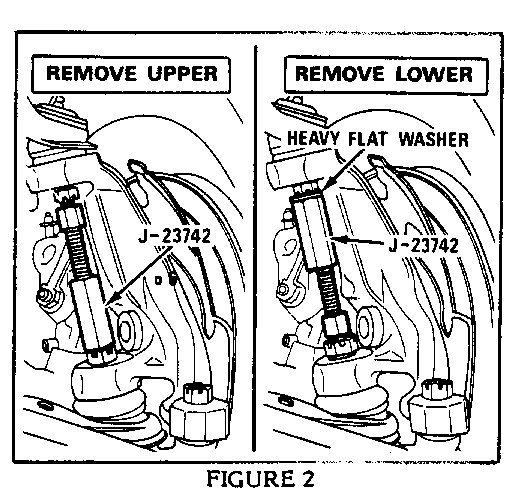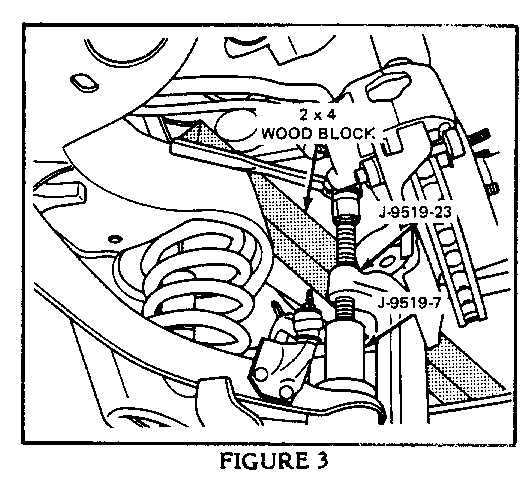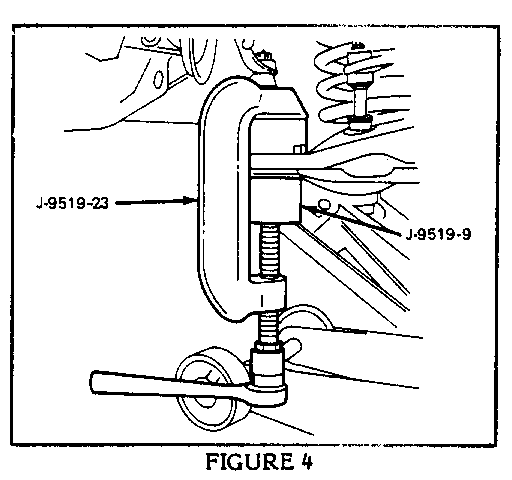CAMPAIGN: LOWER BALL JOINT MAY SEPARATE - LOOSE NUT

SUBJECT: 1981-83 LIMOUSINE AND COMMERCIAL CHASSIS LOWER BALLJOINT MAY SEPARATE
The National Traffic and Motor Vehicle Safety Act, as amended, provides that each vehicle which is subject to a recall campaign of this type must be adequately repaired within a reasonable time af ter the owner has tendered it for repair. Failure to adequately repair within 60 days after tender of a vehicle is prima facie evidence of failure to repair within a reasonable time. If the condition is not adequately repaired within a reasonable time, the owner may be entitled to an identical or reasonably equivalent vehicle at no charge or to a refund of the purchase price less a reasonable allowance for depreciation.
To avoid having to provide these burdensome solutions, every effort must be made to promptly schedule an appointment with each owner and to repair their vehicle as soon as possible. As you will see in reading the attached copy of the letter which is being sent to owners, the owners are being instructed to contact the nearest Cadillac Zone Office if the dealer does not remedy the condition within 5 days of the agreed upon service date. If the condition is not remedied within a reasonable time, owners are instructed on how to contact the National Highway Traffic Safety Administration.
Defect Involved
General Motors has determined that a defect which relates to motor vehicle safety exist in some 1981-1983 Cadillac Limousines and Commercial Chassis. On certain vehicles th front lower control arm balljoint to steering knuckle attaching nuts may not have been tightened to specifications. Under certain conditions, this could cause the nut to back off, resulting in separation of the joint. If joint separation were to occur while the vehicle is in motion, it may affect vehicle directional control which could result in a vehicle crash without prior warning.
To prevent the possibility of this condition occurring on vehicles involved, the front lower control arm balljoint to steering knuckle attaching nuts are to be tightened to specifications. Additionally, a limited number of affected vehicles may require replace ment of the lower control arm balljoints and steering knuckles as instructed in the service procedure of this bulletin.
Vehicles Involved
The vehicies listed below will require this campaign (Cadillac records indicate that a total of 4,254 vehicles are affected):
1981-82 All Limousines and Commercial Chassis 1983 All Limousines and Commercial Chassis within Broadcast range 100001 through 191290
Owner Notification
Owners of all affected vehicles will be notified by Cadillac of the campaign. A copy of the owner letter is attached. A list of those vehicles involved, which our records indicate were sold by you, is enclosed for your follow-up. This listing contains owner names and addresses obtained from State Motor Vehicle Registration records. The use of such motor vehicle registration data for any other purpose is a violation of law in several states. Accordingly, you are urged to limit the use of this listing for the follow-up necessary to complete this campaign.
Parts Information
The parts required to perform this recall procedure will be available from the Parts Distribution Centers of the Warehousing and Distribution Division of General Motors (GMWDD). Two cotter pins will be required for each affected vehicle. In addition, it may also be necessary to replace the lower control arm balljoint(s) and steering knuckle(s) on certain affected vehicles as instructed in the Service Procedure of this bulletin. The table below details the parts that may be required to perform this campaign.
Part Number Description Quantity
103387 Cotter Pin 2 per vehicle 9761498 Lower Control Arm Balljoint as required 3961261 Steering Knuckle L.H. as required 3961262 Steering Knuckle R.H. as required
If there is difficulty in obtaining these parts using normal ordering procedures, the dealer may place a CIO order using Advise Code "2" with no special Instruction Code. The parts may also be ordered on a VIP order; however, unless prior zone approval is obtained, the dealer will be required to absorb any surcharge involved under the VIP system. If any problems are encountered in obtaining these parts, please follow the three-step procedure as stated in the GM Parts Emergency Order Follow-up Procedure (Refer to GM Parts Policy and Procedure Manual, Exhibit 20, Section IV, page 38).
Dealer Campaign Responsibility
Dealers are to perform this recall campaign, at no charge to the owner, on all affected vehicles, regardless of time, mileage, or ownership and are to correct all affected vehicles in dealer new and used car inventory prior to their sale. Whenever a vehicle subject to this campaign is taken into your new or used car inventory in the future, you should take the steps necessary to be sure the campaign correction has been made before reselling the vehicle. In addition, dealers are to perform the campaign on all affected vehicles as they are brought in for any kind of service until all affected vehicles have been corrected.
Service Procedure
1. Raise car on hoist.
IMPORTANT: STEPS 2 AND 3 MUST BE PERFORMED ON BOTH THE RIGHT AND LEFT SIDE OF EACH AFFECTED VEHICLE.
2. Remove-cotter pin from front lower balljoint stud nut.
3. Using a clicker-type torque wrench, set at 50N-m (37 ft.lbs.), tighten the lower balljoint stud nut until the wrench clicks.
a. If the nut turns prior to the wrench clicking, indicating that the torque on the stud nut is less than 50N-m (37 ft.lbs.), the lower balljoint and steering knuckle must be replaced. Proceed to step 4.
b. If the nut does not turn prior to clicking, set the torque wrench at 110N-m (81 ft.lbs.) and tighten the nut until it clicks. Install new cotter pin. Proceed to step 30.
NOTICE: IF COTTER PIN HOLE IS NOT ALIGNED, DO NOT BACK NUT OFF AS LOOSENESS AND EXCESSIVE WEAR MAY RESULT. THE NUT ON THE LOWER BALLJOINT STUD MAY BE TIGHTENED AN ADDITIONAL 1/6 TURN TO A MAXIMUM OF 140N-m (103 ft.lbs.) TO ALIGN COTTER PIN HOLE.
4. Support lower control arm.
5. Remove wheel and tire assembly.
6. Remove tie rod end from steering knuckle using puller J-24319 (Figure 1).
7. Remove brake caliper and hub and rotor assembly. Use a piece of wire to attach caliper to upper control arm.
NOTICE: NEVER ALLOW CALIPER TO HANG FROM BRAKE HOSE AS HOSE MAY BE DAMAGED.
8. Remove splash shield.
9. Loosen, but do not remove, upper and lower balljoint stud nuts.
10. Using tool J-23742, separate upper and lower balljoint studs from steering knuckle (Figure 2).
11. Remove upper and lower stud nuts and remove steering knuckle.
12. Lift up on upper control arm and place a block of wood between frame and upper arm.
13. Place tools J-9519-23 and J-9519-7 in position on lower control arm (Figure 3).
14. Turn hex bolt until lower balljoint is pushed out of suspension arm and remove tools.
15. Position new lower balljoint in lower control arm and install tools J-9519-23 and J-9519-9 (Figure 4). Position bleed vent in balljoint rubber boot to face inward and the stud cotter pin hole to face forward.
16. Turn down on the hex bolt until the new lower balljoint is seated in the lower control arm and remove tools.
17. Remove block of wood holding upper control arm from between frame and upper arm.
18. Place a new teering knuckle into position and insert upper and lower balljoint studs into knuckle bosses.
19. Reinstall upper balljoint stud nut and tighten to 83N.m (61 ft.lbs.). Install new cotter pin.
NOTICE: IF COTTER PIN HOLE IS NOT ALIGNED, DO NOT BACK NUT OFF AS LOOSENESS AND EXCESSIVE WEAR MAY RESULT. THE NUT ON THE UPPER BALLJOINT STUD MAY BE TIGHTENED AN ADDITIONAL 1/6 TURN TO A MAXIMUM OF TO ALIGN COTTER PIN HOLE.
20. Reinstall lower balljoint stud nut and tighten to 110N.m (81 ft.lbs.). Install new cotter pin.
NOTICE: IF COTTER PIN HOLE IS NOT ALIGNED, DO NOT BACK NUT OFF AS LOOSENESS AND EXCESSIVE WEAR MAY RESULT. THE NUT ON THE LOWER BALLJOINT STUD MAY BE TIGHTENED AN ADDITIONAL 1/6 TURN TO A MAXIMUM OF 140 N.m (103 ft.lbs.) TO ALIGN COTTER PIN HOLE.
21. Lubricate new lower balljoint.
22. Reinstall the tie rod end to the steering knuckle and tighten to 54N-m (40 ft.lbs.). Install new cotter pin.
NOTICE: IF COTTER PIN HOLE IS NOT ALIGNED, DO NOT BACK NUT OFF AS LOOSENESS AND EXCESSIVE WEAR MAY RESULT. THE NUT ON THE UPPER BALLJOINT STUO MAY BE TIGHTENED AN ADDITIONAL 1/6 TURN TO A MAXIMUM OF TO ALIGN COTTER PIN HOLE.
23. Reinstall splash shield.
24. Reinstall hub and rotor assembly.
25. Reinstall outer bearing, spindle washer and nut and adjust bearing.
26. Reinstall brake caliper.
27. Reinstall wheel and tire assembly.
28. Lower car.
29. Check front end alignment and reset if necessary.
30. Open hood. Install campaign completion label described in this bulletin and close hood.
Campaign Completion Label
Upon completion of this campaign, a white campaign label (Cat. No. S-1015) should be affixed on a clean, dry surface of the radiator core support in an area clearly visible when the vehicle's hood is raised. Each label provides space to print in ink or type Campaign 83-C-3 and your five-digit dealer code. Dealers are to take the steps necessary to assure that the numbers are properly recorded on the label.
Credit
Credit for this campaign will be issued upon receipt of a properly prepared warranty claim as follows:
A. Tighten right front and left front lower balljoint stud nuts to specified torque.
Part Part Failure Labor Labor Qty. No. Code Operation Hours --- --- ---- --------- ----- 2 103387 96 V1700 .4
B. Replace steering knuckle and lower ball joint on one side and tighten balljoint stud nut on opposite side.
Part Part Failure Labor Labor Qty. No. Code Operation Hours ---- ---- ---- ---------- ----- 4 9761498 96 V1701 2.3
C. Replace steering knuckle and lower balljoint on both sides. (NOTE: Prior zone approval will be required if replacement of the steering knuckle and balljoint is required on both sides).
Part Part Failure Labor Labor Qty. No. Code Operation Hours ---- ---- ---- --------- ----- 6 9761498 96 V1702 3.0
The labor time listed above represents the actual time required to perform the correction. Dealers should apply for 0.1 additional hour for administrative allowance as "Other Labor Hours".
Dear Cadillac Owner:
This notice is sent to you in accordance with the requirements of the National Traffic and Motor Vehicle Safety Act.
General Motors has determined that a defect which relates to motor vehicle safety exists in some 1981-1983 Cadillac Limousines and Commercial Chassis. On certain vehicles the front lower control arm balljoint to steering knuckle attaching nuts may not have been tightened to specifications. Under certain conditions, this could cause the nut to back off, resulting in separation of the joint. If joint separation were to occur while the vehicle is in motion, it may affect vehicle directional control which could result in a vehicle crash without prior warning.
To prevent the possibility of this condition occurring on your vehicle, please contact your Cadillac dealer to arrange a service date to have your vehicle corrected. Your dealer will inspect and, if necessary, tighten the lower control arm balljoint to steering knuckle attaching nuts. If necessary, your dealer will replace the lower control arm balljoints and steering knuckles. This service will be performed at no charge to you.
Instructions for making this correction have been sent to your Cadillac dealer. Parts will be available approximately July 13, 1983. The labor time necessary to perform this correction is approximately one-half hour to tighten the attaching nuts or approximately three hours if it is necessary to replace the lower control arm balljoints and steering knuckles. Please allow additional time for your dealer to process your vehicle.
Your Cadillac dealer is best equipped to obtain parts and provide service to assure your vehicle is corrected as promptly as possible. However, if you take your vehicle to your dealer on the agreed service date and they do not remedy this condition on that date or within five days, we recommend you contact your nearest Cadillac Zone Office, either in person or by telephone. The zone office will assist you and your dealer in getting your vehicle corrected. The locations and telephone numbers of the zone offices are listed in your Owner's Manual.
After contacting your dealer and the zone office, if you are still not satisfied that we have done our best to remedy this condition without charge within a reasonable time, you may wish to write the Administrator, National Highway Traffic Safety Administration, 400 Seventh Street, S.W., Washington, D.C. 20590, or call 800- 424-9393 (Washington, D.C. residents use 426-0123).
The enclosed owner Identification Card identifies your vehicle. Presentation of this card to your dealer will assist in making the necessary correction to your vehicle in the shortest possible time. If you have sold or traded your vehicle, please let us know by completing the postage-paid card and returning it to us. This will assist us in assuring all affected vehicles have been corrected and will eliminate the necessity for contacting you during any subsequent follow-up notifications.
We are sorry to cause you this inconvenience; however, we have taken this action in the interest of your safety and continued satisfaction with our products.




General Motors bulletins are intended for use by professional technicians, not a "do-it-yourselfer". They are written to inform those technicians of conditions that may occur on some vehicles, or to provide information that could assist in the proper service of a vehicle. Properly trained technicians have the equipment, tools, safety instructions and know-how to do a job properly and safely. If a condition is described, do not assume that the bulletin applies to your vehicle, or that your vehicle will have that condition. See a General Motors dealer servicing your brand of General Motors vehicle for information on whether your vehicle may benefit from the information.
